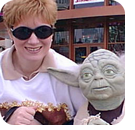|
In this issue LEGAL BRIEF: Trust no one: The case for blockchain Additional articles in the PLUS issue LANGALIST: ‘Shell’ Extensions; Quick Assist; and moving a spinning HDD FREEWARE SPOTLIGHT: Five tiny tweaks — with Registry files! ON SECURITY: Extra security for all your devices
LEGAL BRIEF Trust no one: The case for blockchain
By Max Stul Oppenheimer, Esq. How you read the title above says a lot about how you should approach blockchain and its popular implementations (cryptocurrency and NFTs). If you read it as “there is no one who can be trusted,” then cryptocurrency may be of interest as a way to keep your finances hidden from the prying eyes of others (perhaps, notably, the government). However, if you read it as “trust the crowd rather than anyone in particular,” then blockchain may offer the means for reaching your goal, offering a way to establish ownership without having to trust any one individual or entity. In either case, you are using a tool and should respect its limitations and risks. The difference between possession and contracts: Trust
Think about your most recent deposit to your bank account. You took a piece of paper (a check, which represented a contractual promise to pay you; or a stack of federal reserve notes, which represent a promise by the Federal Reserve to pay you) to a bank. Or you captured an image of that piece of paper and transmitted it electronically to the bank. Or your promisor sent an electronic message to your bank, instructing it to move money from their account to yours. What do you now own that you didn’t own before the transaction — and whom did you trust? You own a contractual claim against your bank for the additional number of dollars (or whatever currency you operate in) you deposited. You trusted the bank to do a number of things: to credit the deposit properly (the right amount to the right account), to keep the money in your account (not to give it to someone else without your permission), and to return the money to you (or to another account or person at your direction) when you ask them to. “In [fill in the blank] we trust”
Why should you trust the bank? In the United States, banks require a federal or state license, are periodically examined to be sure they are able to fulfill their obligations to depositors, and deposits are covered by insurance up to certain limits. This government oversight, though, means that the details of your finances are not private (although, in most cases, those with access to those details are sworn to secrecy). In essence, most financial transactions do not involve physical assets directly — they are the reflection of a series of promises (or, in legal terms, contracts). Credit-card transactions are similar, although they involve more parties and more complicated contractual relationships. Similarly, most uses of blockchain are reflections of promises, not transfer of physical assets. Blockchain transactions differ from conventional transactions in one important respect: there is no “one” who is trusted. If you buy a car, there is an official (government) repository of the title to the car. That is not the car — it is a record of who the officially recognized owner of the car is. If you buy a blockchain asset — for example, an NFT (nonfungible token) — the blockchain records the official ownership of the asset; it is not the asset itself. Like car ownership, the official record of title is in one place; the actual property is elsewhere. Unlike the motor vehicle title, no official government agency can verify your ownership of the NFT. Commercial entitites ranging from banks and credit-card companies to sports teams and (if their recent trademark actions are any indication) large retailers like Walmart are looking seriously at blockchain assets as new sources of revenue. Even sovereign nations are considering accepting cryptocurrency as legal tender; the US Federal Reserve issued a whitepaper last month, soliciting comments on the possibility of a US Central Bank Digital Currency (CBDC). Of course, a US government–backed digital currency would offer great security and stability. (As of this writing, Bitcoin is trading at about $37,750, having ranged between $28,800 and $68,900 over the past year; the US Dollar has ranged between, well, $1 and $1 over the same period.) It would also offer great liquidity, but at the cost of privacy. The white paper states that one of the attributes of a CBDC would be privacy, and it qualifies what it means by privacy: “Any CBDC would need to strike an appropriate balance … between safeguarding the privacy rights of consumers and affording the transparency necessary to deter criminal activity.” Knowing and managing the risks and rewards
So, what does the consumer need to know about blockchain and its applications, such as NFTs and digital currency? Pretty much the same thing the consumer needs to know about any contract (because blockchain transactions are contracts): what are the terms of the contract, exactly what is being bought/sold, and how reliable is the counterparty? That means reading the terms of service and the description of the property in question as well as searching the party who is selling the property to see whether they are reliable. As with any contract, until it is fully performed, there is a risk that the party on the other side will fail to perform — leaving you with a legal cause of action for breach of contract. (This assumes that you can physically locate the other party and that they reside in a jurisdiction that you would be willing to visit in order to pursue your lawsuit.) There are a few additional things to consider that are specific to blockchain transactions. First, what is stored on the blockchain is generally a record of a property transaction (for example, a purchase and sale), not the property itself. This is akin to the recorded deed to your house differing from your house. What that record means depends on the terms of service for the registrar of the transaction and the terms of the transaction itself. Particularly with respect to NFTs, purchasing a work of art does not ordinarily carry with it the copyright to that work of art. Therefore, buying an NFT does not ordinarily mean that you can make copies (physically or digitally) or publicly display it. Those are among the rights that belong to the copyright holder, not the owner of the physical work. Finally, while privacy is often a goal of using cryptocurrency or other blockchain tools, it does not happen automatically — users must take steps to conceal their identity. The blockchain is, by design, an open public record of transactions. For example, a transaction identified on a seller’s website will include the block where the transaction is recorded. That block can be searched at the cryptocurrency website and linked (if not to the specific user) to other transactions by that user. Blockchain transactions are also slow, compared to the instant gratification response of, say, an Amazon.com or Walmart.com transaction. A recent msn.com article indicates that Bitcoin can complete seven transactions per second; Ethereum 14, about one per minute. (A “minute” was an ancient measure of time, used before the invention of the nanosecond.) Keep in mind that blockchain transactions are not free. Blockchain transactions involve a “gas fee,” which is variable and depends on factors such as time of day and complexity of the transaction. That fee gets paid every time you participate in a transaction (e.g., once when you buy, once when you sell) — and although you may be anonymous to the public or the tax collector, the blockchain knows who you are and will have no trouble collecting its “tax.” Blockchain is a tool. It can be useful; but as with any tool, it is important to know how to use it and what risks are involved. That knowledge is especially important with such a rapidly evolving tool.
Max Stul Oppenheimer is a tenured full professor at the University of Baltimore School of Law, where he teaches business and intellectual property law. He is a registered patent attorney licensed to practice law in Maryland and D.C. Any opinions expressed in this article are his and are not intended as legal advice.
You’re welcome to share! Do you know someone who would benefit from the information in this newsletter? Feel free to forward it to them. And encourage them to subscribe via our online signup form — it’s completely free!
The AskWoody Newsletters are published by AskWoody Tech LLC, Fresno, CA USA.
Your subscription:
Microsoft and Windows are registered trademarks of Microsoft Corporation. AskWoody, AskWoody.com, Windows Secrets Newsletter, WindowsSecrets.com, WinFind, Windows Gizmos, Security Baseline, Perimeter Scan, Wacky Web Week, the Windows Secrets Logo Design (W, S or road, and Star), and the slogan Everything Microsoft Forgot to Mention all are trademarks and service marks of AskWoody Tech LLC. All other marks are the trademarks or service marks of their respective owners. Copyright ©2022 AskWoody Tech LLC. All rights reserved. |
||||||||||||||||||||||||












